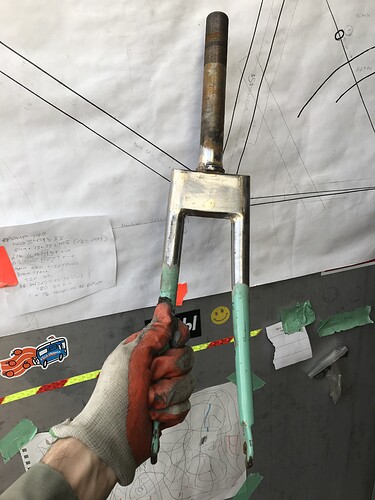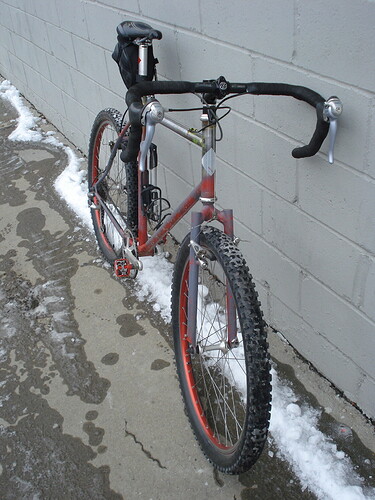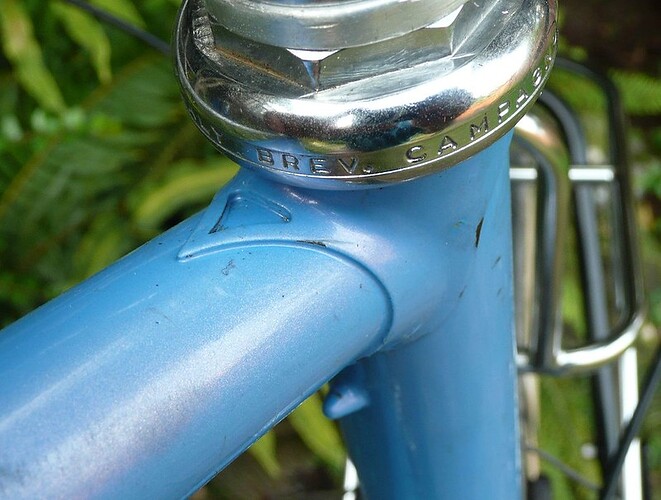The following is not advice to a beginner/hobbyist, just a sort of memoire.
At Davidson circa late-'80s we got really fast at making steel forks, just in time for them to become obsolete! Bill made a carousel like he saw in Italy, a heavy rotating table (spun on a Volvo wheel bearing) with 4 jigs on it. Pneumatic actuators controlled by foot pedal locked/unlocked the table, and moved the rosebud torches out of the way to allow the table to rotate, then back in to heat the next fork. One guy (typically an apprentice) fluxes and assembles and rotates the table, and takes finished forks off as they come back around. The other guy is the brazer, that was usually me. Both workers have to work fast to keep up with each other, it was exhausting but actually kinda fun. We never made more than 50 forks in a session, so you didn’t have to do it all day every day. I’d have quit if that was the job!
We brazed crown steerer and blades in one go, with brass preforms inside, heated up at a heating station with two large oxy-propane rosebuds. When the fork gets to the brazer it is already at brazing temperature, so you just need to add the heat of fusion in the preforms, and watch the brass emerge everywhere around the shoreline. Destructive testing confirmed 100% penetration, pretty much no way for it to fail. And absolutely zero blobs or spatter, really nothing to clean off afterward, we didn’t even char the flux.
A bit of brass is added thru the brake holes, but the steerer also had a preform, a thin washer of brass between the cut end of the steerer and the shelf in the crown. (The crowns all had shelves, as opposed to a through-bore, so the steerer cannot poke out the bottom of the crown.) Crowns without a shelf would require some other step to prevent the crown sliding up the steerer as the parts all get longer from heat expansion. Though if you know how much movement there will be, from testing, you could just start with the steerer backed off by that amount before heating, so that it ends up in the right spot when everything expands. I think most people would rather just pin it though.
This carousel could (typically did) braze 50 forks in 50 minutes, maybe an hour max if we were slackin’. So an average of one minute to braze each one. That’s two man-minutes of labor per each, but the steel only cares how long it was hot for.
The blades are straight at this point. After the flux soak, brake hole drilled, and a quick alignment check, both blades get raked at once (requires two raking forms of course). Then the little straight part, that you always get past the bottom of the curve, are cut off roughly to length with a chop-saw, in a fixture that indexes off the brake hole. The blades get reamed and faced on the lathe in another fixture that indexes off the brake hole, real square and precise unlike the chop-saw.
Reamed and faced with a cutter just like a head tube reamer-facer, only tiny. This is to make them fit perfectly with the internal-plug-style dropouts we used. Those get brazed with preforms of course, takes like ten seconds each with two rosebuds in your hands. Since the dropouts were precisely the same length, brazed into blades that were also, the wheel always centered just right with no faffing about.
Davidson had previously used forks made by Tange in Japan, for his production models. But after the system described above was worked out, it was cheaper to make them in-house than to buy Tange forks, and the quality was higher. We also made batches of forks for a couple other brands that you have heard of. I think they get client confidentiality since they sold them as forks they’d made. I don’t snitch.
Fun times. I wonder what happened to that carousel. Cut up for scrap?







